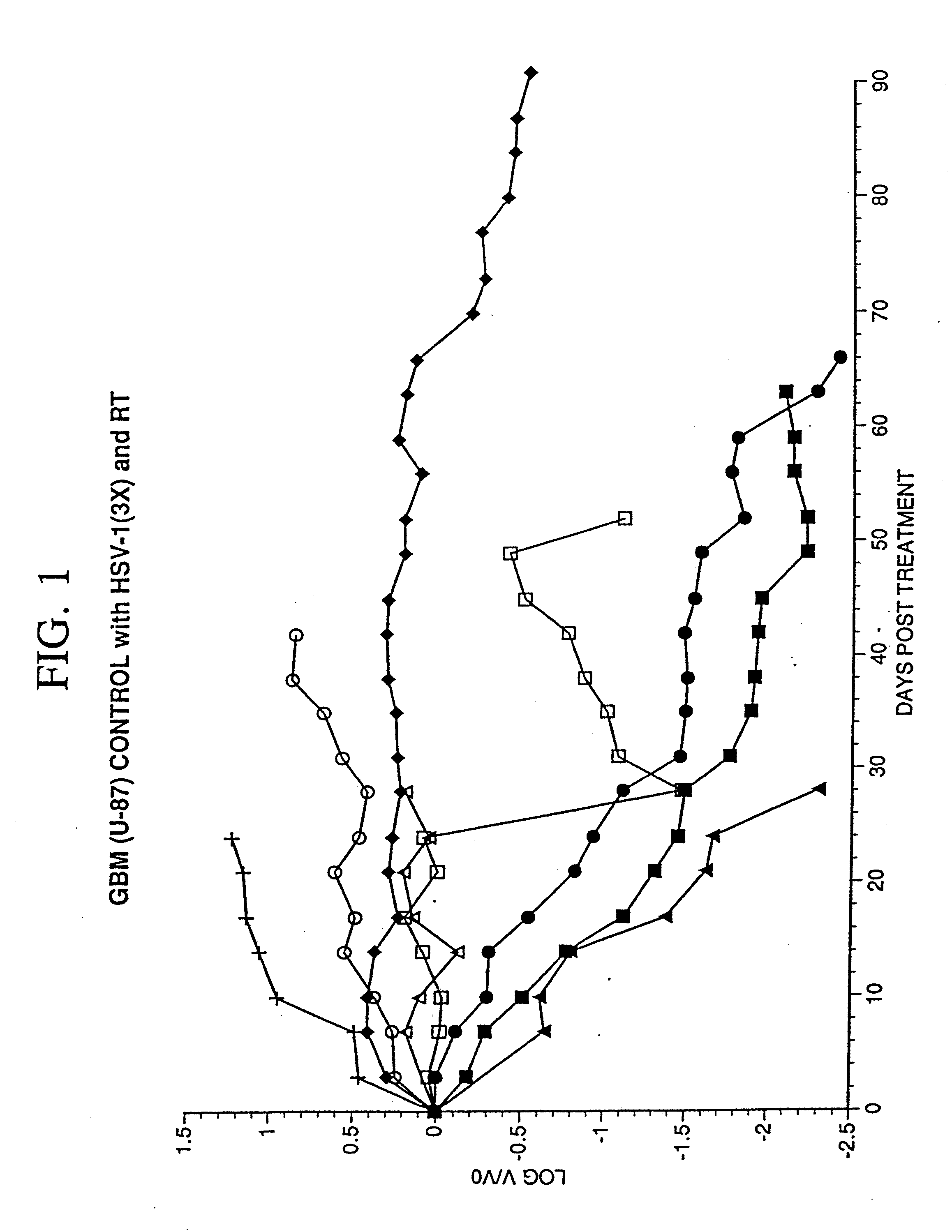Methods and Compositions for Viral Enhancement of Cell Killing
a cell killing and viral technology, applied in the field of methods, to achieve the effect of increasing the therapeutic ratio in cancer treatmen
- Summary
- Abstract
- Description
- Claims
- Application Information
AI Technical Summary
Benefits of technology
Problems solved by technology
Method used
Image
Examples
example i
Viral Enhancement of Tumor Control With Radiation Therapy
Background
[0064] The present inventors have utilized viral vectors to deliver gene therapy to human tumor xenografts (Hallahan et al., 1995; Sibley et al., 1995). Vector without the TNF gene was used as a control in the treatment of these tumors. These studies indicated that the viral vectors enhanced tumor control by x-irradiation.
Herpes Simplex Virus (HSV)
[0065] The objective of the studies described here was to establish a model of malignant glioma in mice and to compare the effectiveness of R3616 and R4009 in treatment of this tumor in the murine model.
Methods:
Viruses
[0066] R3616 was created by a deletion of the gene conferring neurovirulence, γ34.5. An Egr-TNF-α construct was also created by ligating the Egr-1 enhancer / promoter region upstream to the human TNF-α gene, which construct was then inserted into the γ34.5 locus by recombination. This modified virus was designated R899-6.
Growth of Human Xenografts ...
example ii
Adenovirus Type 5 Enhances Tumor Control by X-Irradiation
[0078] The replication deficient adenovirus type 5 (Ad5) genome (McGrory et al., 1988; Jones et al., 1979) has been shown to infect human epithelial carcinoma cells (Hallahan, 1995; O'Malley, 1995).
[0079] In the present study, human colon carcinoma cells (106 WiDr cells) were injected into the hindlimbs of nude mice and tumors were grown to a mean tumor volume of 260 mm3. Xenografts were injected with 2×108 PFU of Ad5.null, two injections per week for a total of four weeks. As used herein, AD5.null is the replication deficient adenovirus type 5 that does not contain foreign genes to be expressed, such as therapeutic genes. Control tumors were either not injected or injected with an equivalent volume of buffered saline. An E1a, partial E1b, partial E3{umlaut over ( )}Ad5 based adenovirus vector was modified to contain an expression cassette that replaced the E1 region with the Egr enhancer / promoter coupled to the gene encodi...
example iii
Treatment Protocols
[0088] This prophetic example describes some ways in which the methods of the invention may be used to treat neoplastic disease. [0089] 1) Patients exhibiting neoplastic disease are treated a virus for example an adenovirus, at a titer of at between about 108 to about 1011 virus particles, for 6 hours prior to exposure to a DNA damaging agent. [0090] 2) Patients are exposed to a DNA damaging agent, e.g. ionizing radiation (2 gy / day for up to 35 days), or an approximate a total dosage of 700 Gy. [0091] 3) As an alternative to ionizing radiation exposure, patients are treated with a single intravenous dose of mitomycin C at a dose of 20 mg / m2.
[0092] It is contemplated that ionizing radiation treatment in combination with a virus, such as an adenovirus, will be effective against cancers of the brain, lung and breast, as well as other neoplasms.
PUM
| Property | Measurement | Unit |
|---|---|---|
| delay time | aaaaa | aaaaa |
| delay time | aaaaa | aaaaa |
| delay time | aaaaa | aaaaa |
Abstract
Description
Claims
Application Information
 Login to View More
Login to View More - R&D
- Intellectual Property
- Life Sciences
- Materials
- Tech Scout
- Unparalleled Data Quality
- Higher Quality Content
- 60% Fewer Hallucinations
Browse by: Latest US Patents, China's latest patents, Technical Efficacy Thesaurus, Application Domain, Technology Topic, Popular Technical Reports.
© 2025 PatSnap. All rights reserved.Legal|Privacy policy|Modern Slavery Act Transparency Statement|Sitemap|About US| Contact US: help@patsnap.com



